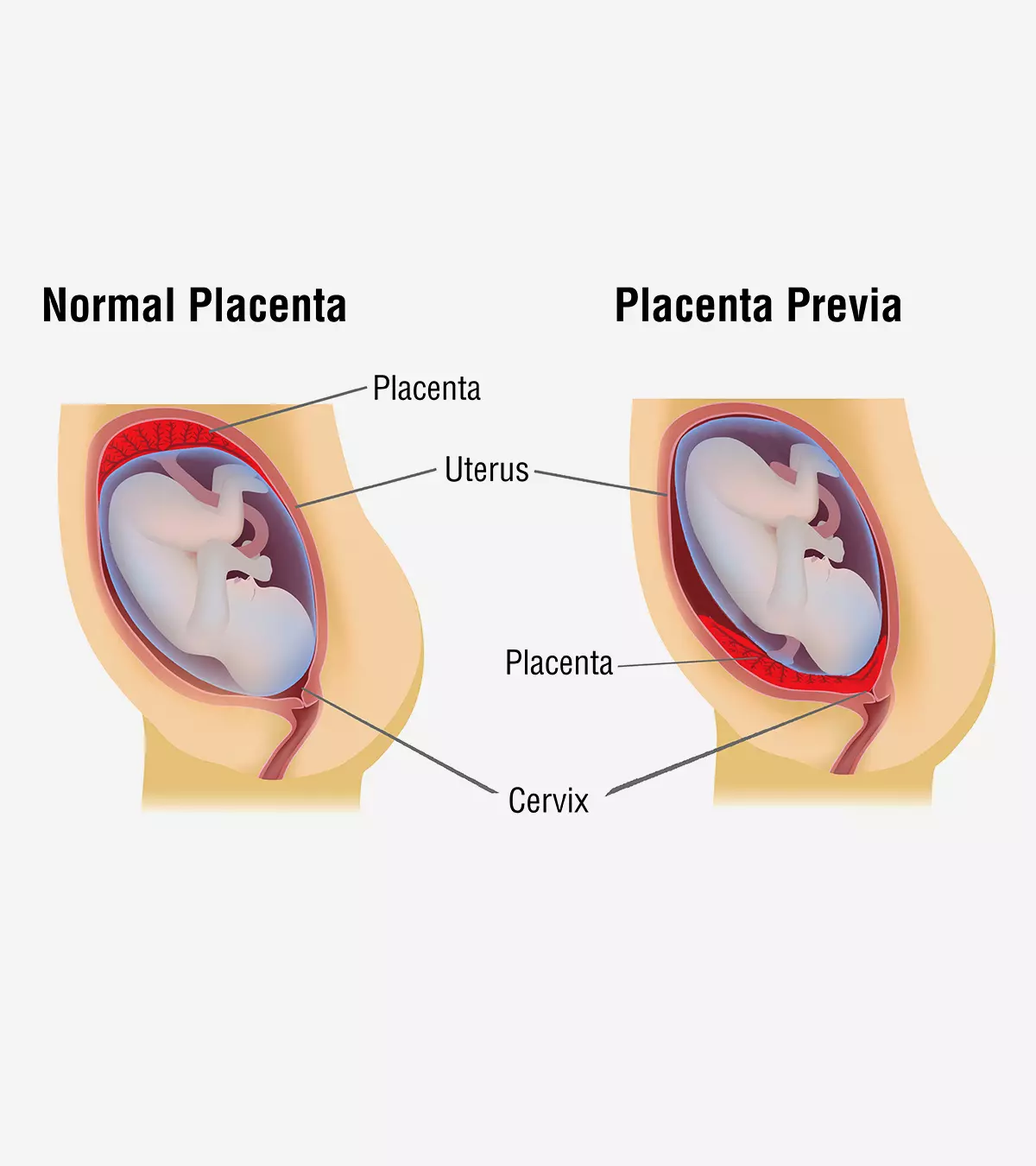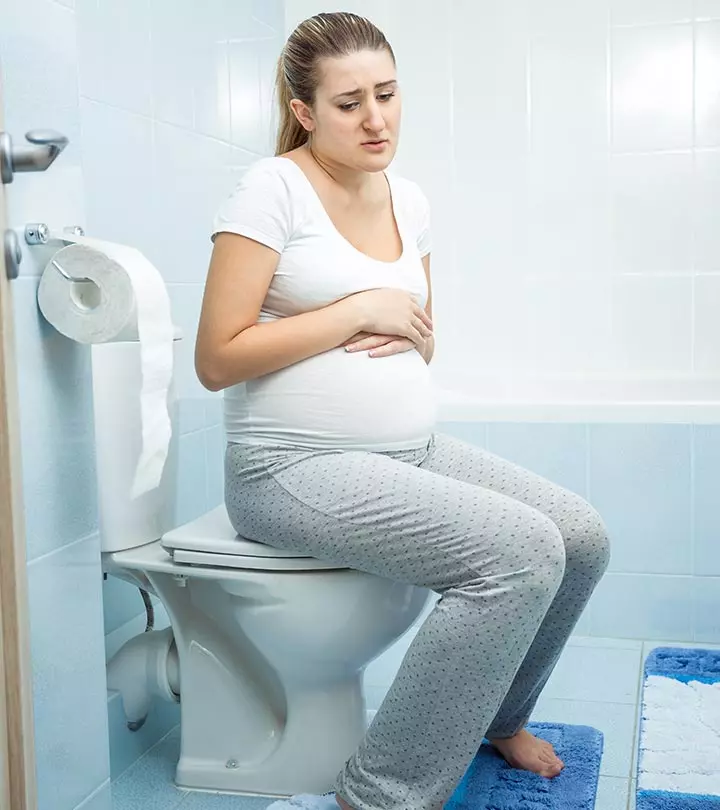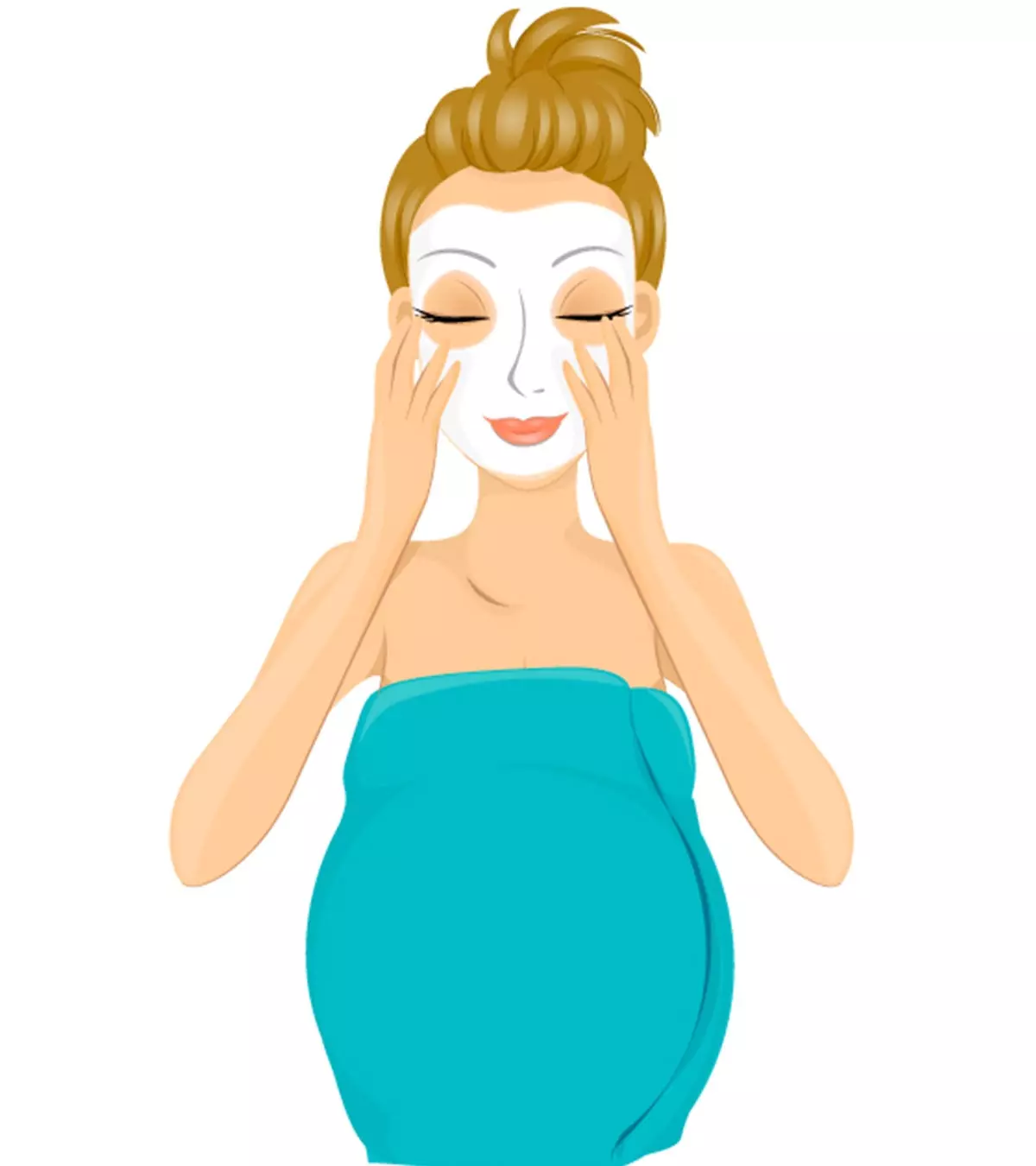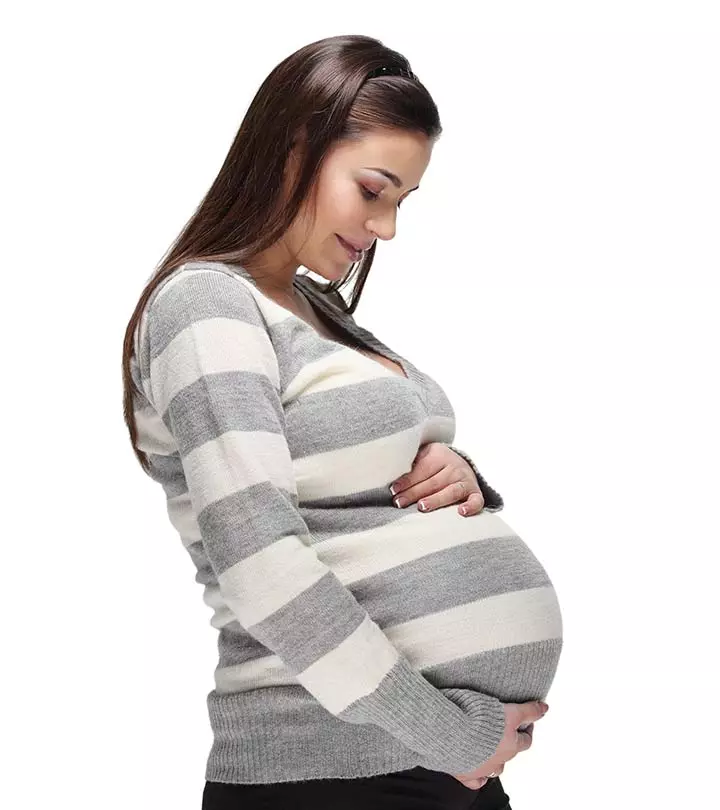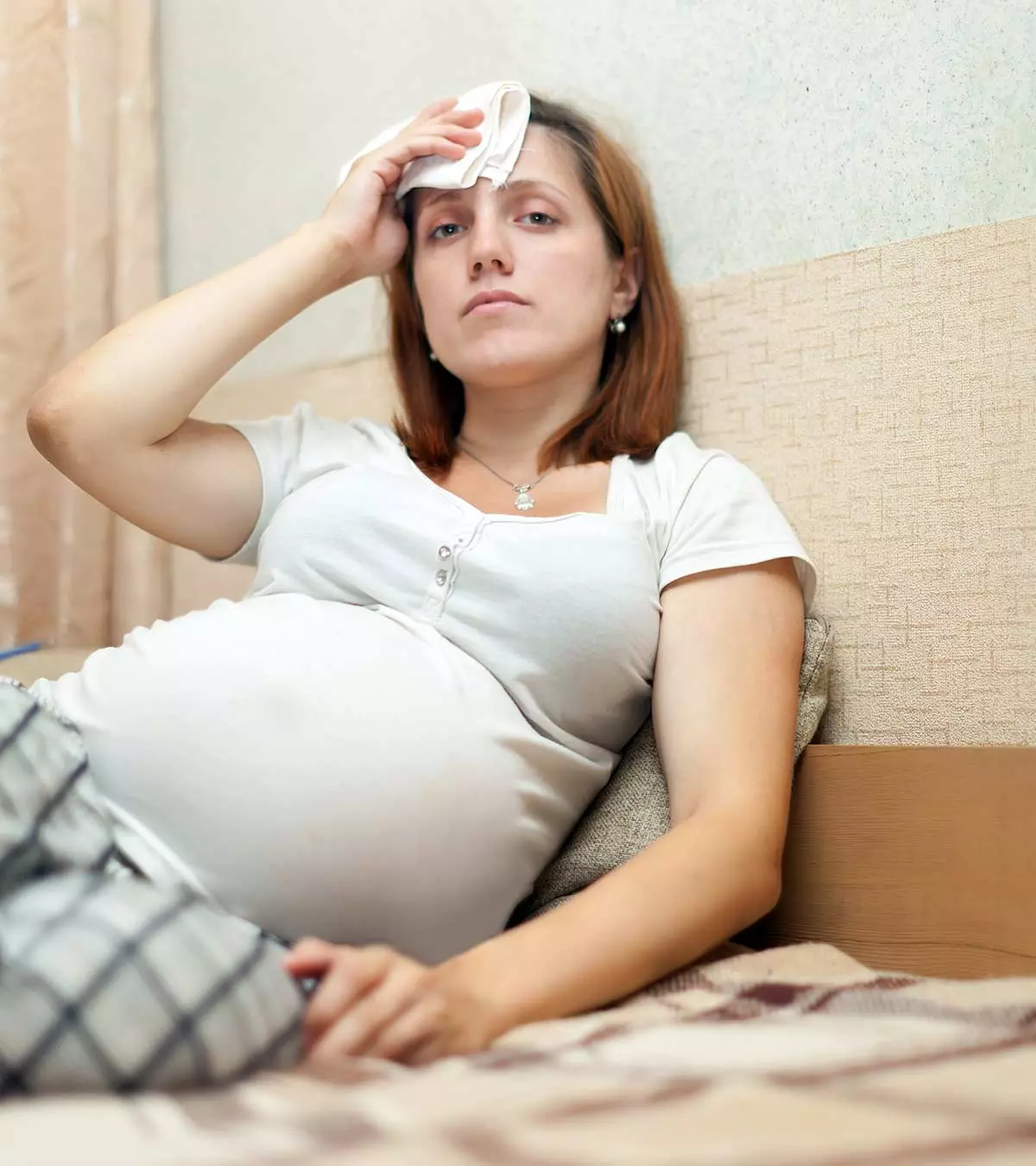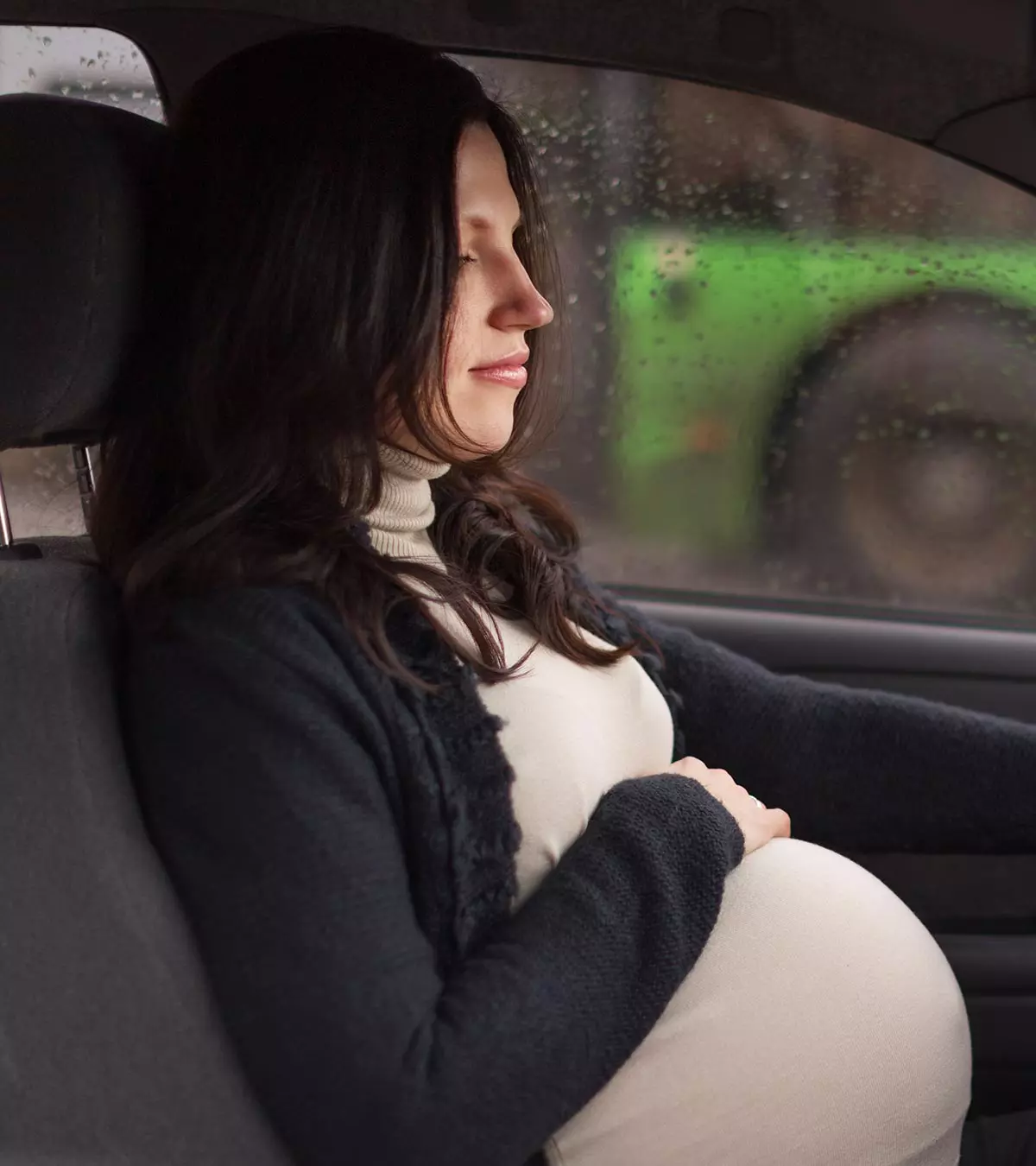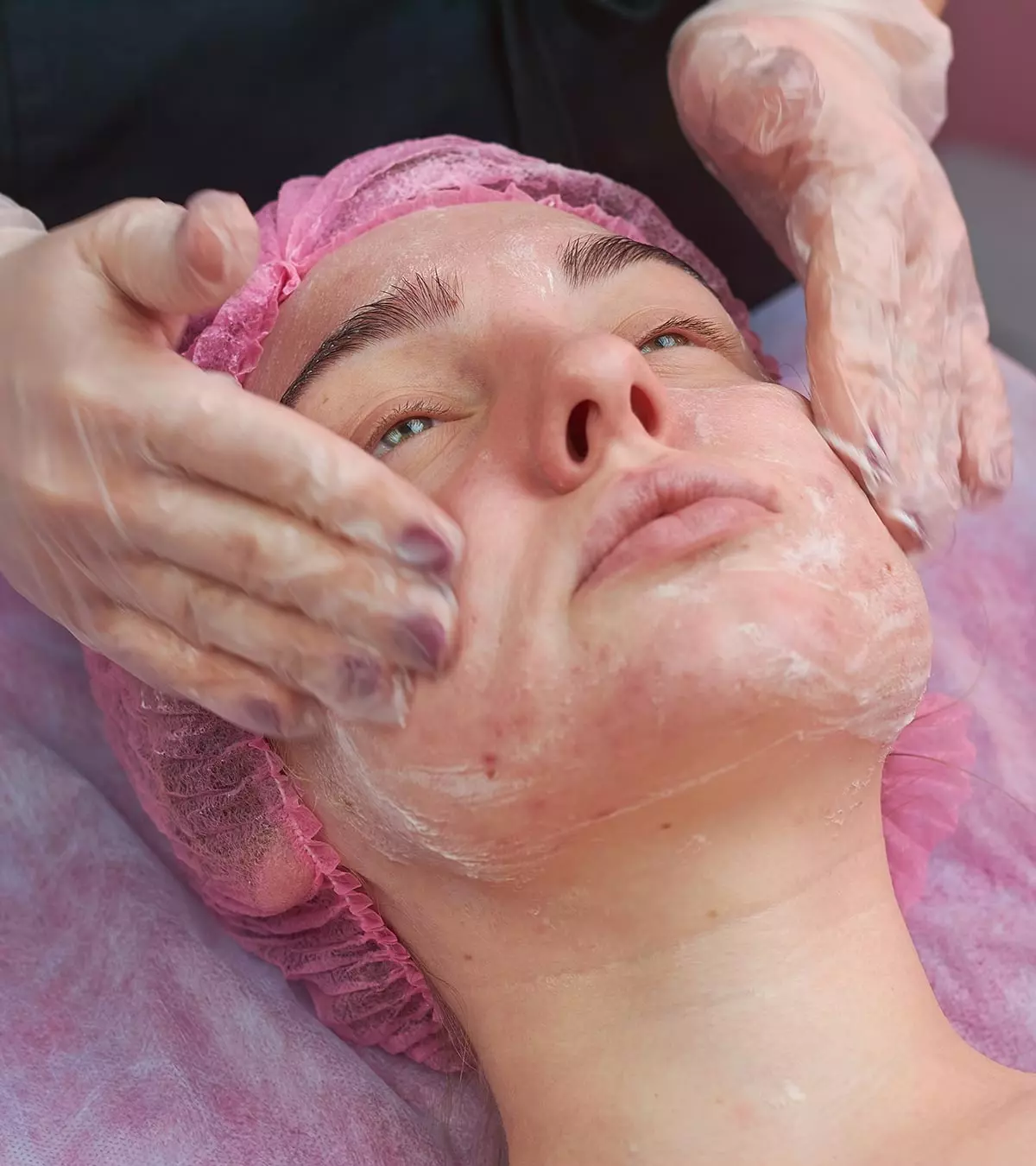
Image: Shutterstock
It is adorable to watch a baby sleep in a swing, but you may wonder why experts recommend cribs for babies to sleep. A baby sleeping in a swing has an increased risk for positional asphyxiation, and the subject experts do not recommend it. It is better to transfer a baby from a swing to a crib as soon as they fall asleep. Some babies may love to fall asleep in the swing with swift movements. You should never place your babies in swings and rockers unsupervised. A firm flat surface with proper back support, such as a crib, is the preferred safe sleeping place for infants. Read on to learn why baby sleeping in swings is unsafe, how to use swings safely, and what to do if your baby only prefers to sleep in swings.

Key Pointers
- It is not safe to let your baby sleep in the swing, and you may only keep the baby on the swing for playtime.
- Loose and soft bedding of the swings and weak muscle strength in babies could increase the risk for positional asphyxiation, acid reflux, and container baby syndrome.
- You may allow the baby in the swing during their playtime, and the baby must only sleep in a crib or bassinet.
Is It Safe For The Baby To Sleep In A Swing?
No, placing the baby in the swing for playtime is allowable, but letting the baby doze off in the swing is unsafe. Here are the reasons why swings are inappropriate as sleeping places for babies.
- Loose bedding: Research shows that most mothers, 78%, prefer placing their babies on their backs to sleep. Meanwhile, 42.4% avoid using soft bedding (1). However, when babies are placed on loose bedding in a swing, it is observed that babies sleeping on their sides is found more commonly than them sleeping on their backs. The loose bedding and padding may pose as suffocation hazards for babies, and could increase the risk of sudden infant death syndrome (SIDS) in babies younger than a year (2). According to Centers for Disease Control and Prevention (CDC) data, about 3,400 sudden unexpected infant deaths (SUID) occur annually in the US (3). Therefore, it is important that you do not let your baby sleep in the swing to avoid such risks.
- Weak muscle strength in babies: Infants lack adequate muscle strength to support their heads and keep their necks straight. Just like how you support a baby’s head with your hand when you pick them up, babies need support during sleep, too. A swing may not be able to provide the required head and neck support.
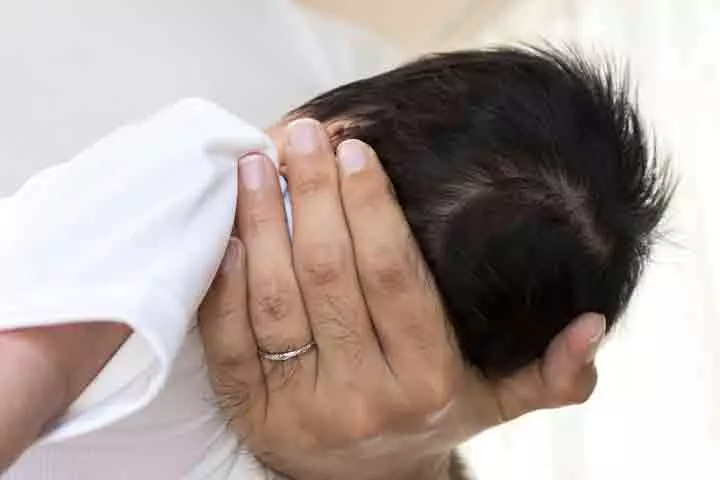
- Positional asphyxiationiwhen your body doesn't get enough oxygen, causing a risk of fainting : In a swing, there are chances of baby sleeping on their stomach or sides, which may cause rebreathing of exhaled air. This leads to low oxygen levels and carbon dioxide buildup encircling the baby, increasing the risk of positional asphyxiation (4).
 Be watchful
Be watchful- Container baby syndrome: The swing limits the baby’s movements and imparts inappropriate stress on their developing joints and bones. Sustained use of a swing for sleeping may increase the risk of container baby syndrome. It may cause a delay in achieving physical milestones, such as rolling and sitting, and cause musculoskeletal issues, such as torticollis (5).
- Safety issues associated with a swing: Falls from swings, strangulations, tearing of bad quality swing material, and injuries due to bumping of the swing, are some major risks associated with a swing (6).
- Worsening acid reflux: Some parents may place their baby with acid reflux on a swing believing that the semi-inclined position could improve the condition. However, according to Dr. Anthony Porto from the American Academy of Pediatrics, sleeping on the back is the best way to sleep, even for babies with acid reflux, as the semi-inclined position of the baby in a swing may worsen some symptoms of acid reflux (7).

How To Use A Baby Swing Safely?
The American Academy of Pediatrics states, “If the baby falls asleep in a swing, car seat or bouncy seat, move the child to a firm sleep surface as soon as possible (8).” Do not use swings for sleeping and napping, but use them only for playing once the baby starts sitting and holding up their head on their own, which is by the age of six months (9). Observing the following tips could help in the safe use of swing in babies.
- Use only during playtime: Swinging can be fun when the baby uses the swing while awake. Playing appropriate games and activities while the baby is on the swing could help develop the little one’s sensory and motor skills.

- Soothe the baby in it: Swings are great options to calm a fussy baby. Swinging relaxes the body and lifts the mood. Use swinging to lull the baby, and once the baby seems sleepy, transfer them to the crib.
- Monitor the swing time: Regulate the speed and the motion of swinging according to the tolerance of the baby, and see to it that an upright position is maintained. Make sure that the baby has access to plenty of fresh air (10).
- Use swing sets: A portable swing set can be carried to a garden, where the baby can enjoy the world around them, get sunlight and fresh oxygen, and interact with the surroundings. Also, swing sets with leg holes support the baby to be in an upright position.
- Check for wear and tear: Buy a good-quality swing for your baby with strong straps that can bear your baby’s weight. Before using a preloved or a secondhand swing, inspect for the sturdiness of the straps of the baby swing and check for any potential wear and tear. Using new swings is preferable to prevent any potential mishaps.
- Use swings as directed by the manufacturer: Read the directions for correct use provided on the packaging. Check for any buckles, attachments, or belts provided, and understand their correct usage. Note the height and weight limits mentioned for the swing.
 Quick tip
Quick tipHow To Break The Baby’s Habit Of Sleeping In A Swing?
If you regularly place the baby for naps in a swing, chances are they could become habituated to it.
Here are a few things you can try to break the baby’s habit of snoozing off in a swing and make them sleep in a crib or bassinet instead.
- Habituate sleeping in cribs and bassinet: Once your baby falls asleep in a swing, transfer them to a crib or bassinet immediately. Try doing so as gently as possible to prevent awakening the baby. Gradually, start placing the baby in the crib right when they become drowsy. Be consistent in using the crib/bassinet, and use the crib for both naps and nighttime sleep. It can help the baby associate the crib as a place for slumber (11).
- Try a sleep routine: Observe a sleep routine to calm the baby enough that they can comfortably fall asleep in the crib. Give them a warm bath, feed them, and read them a book before they become drowsy and ready to sleep in the crib.
- Keep the baby awake in a swing: Make the baby associate the swing as a place to remain awake and play rather than sleep. Keep the baby occupied for all the time they spend in a swing; talk to them, give them a toy to explore, or play a game to keep them engaged and awake.
- Place the swing near the crib: When the baby becomes drowsy, shift them to the crib, and when they are awake, shift them to the swing. A quick transition from the swing to the crib may help some babies adapt to sleeping in the crib quickly.
- Maintain a consistent sleep environment: Always keep the baby’s room quiet and dark so that they have an easier time relaxing inside the crib (12). Place the crib in exactly the same spot and in the same room. A consistent sleep environment could make it easier to make the baby rest independently in a crib.
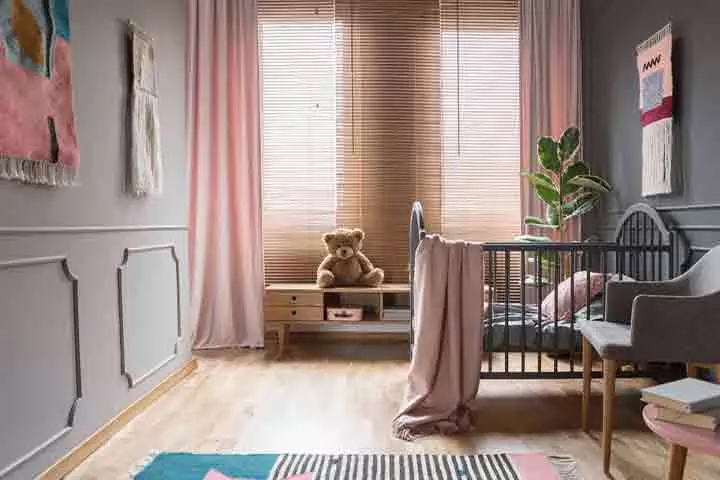
- Use pacifiers: Using a pacifier after your baby is three to four weeks old can be an effective method to help them fall asleep. It reduces the risk of SIDS in babies, and provides temporary distractions needed for transitions from a swing to a crib (13).
- Swaddle: Swaddling could make the baby feel warm and cozy, and calm them enough to accept the crib as a place to sleep. Stop swaddling the baby once they are two months old, which is the age when they try rolling over (14). Swaddling helps the baby feel the warmth or comfort of the mother’s womb and accept the crib as their sleeping place.
- Massage: A gentle massage acts as a soothing therapy for babies, as it relaxes them, reduces crying, and results in a sound sleep. After a massage, place the baby in a crib or bassinet for sleep. Do not massage the baby soon after feeding, as it may cause vomiting. Wait for 45 minutes after feeding to give a baby massage (15).
- Gently rock in arms: The rocking motion could soothe the baby before you place them in a crib. Once the baby seems drowsy, place them in their crib to fall asleep. Avoid doing it regularly and keep rocking for the moments when the baby acts fussy (16).
- Sing and read: You can try singing lullabies or some songs to lull the baby in a crib (17). Try multiple songs or stick to one lullaby that gets your baby to sleep faster.
Safe Alternatives To Swings
Below are some of the safe alternatives to a swing for babies (18).
- Cribs: This infant bed, also called a cot, is the safest option for babies to sleep (19). The firm surface is ideal for babies to sleep, and the sidebars provide support when babies begin to stand.
- Bassinets: It is a baby basket fixed on top of legs. A bassinet is easy to move from one place to another inside the house. Some are foldable and portable for easy carrying while traveling.
- Cradles: These are studier than bassinets and smaller than the cribs. Cradles can be rocked to lull the baby, and some of them even have wheels for easy movement.
- Playards: Playards are enclosed and secure spaces where you can put your baby to play or sleep. They either have mesh or fiber They are larger than cribs and bassinets and are portable (20). However, make sure to supervise your baby when inside the playards, especially if using a mesh playard for babies. Also, playards usually have bedding included, so make sure to buy a play yard appropriate for your baby’s age, weight, and height (21).
Frequently Asked Questions
1. How long can I let my baby stay in a swing?
The swing time should be limited to an hour or less in a day. Activities like crawling, sitting, and standing cannot develop in a swing. Therefore, swings should only be used during playtime activity and as a means to soothe a fussy baby.
2. Should my baby take naps in the swing?
No, swings should not be used for naps. Place the baby in a crib even for daytime naps, just like how you would place them for nighttime sleep.
3. Can a swing help soothe my fussy baby?
A swing could help soothe a fussy baby since the swinging motion helps a baby calm down.
4. Can I use a boppy lounger for babies to sleep, instead of a swing?
No, boppy loungers are to be used when the baby is awake. It is not safe for babies to sleep in a boppy lounger.
5. Can swinging a baby cause brain damage?
Gentle swinging is not known to cause harm to the baby. However, vigorous swinging may injure their necks since their neck muscles are not as strong as adults. Moreover, shaking a baby may cause brain damage by causing internal bleeding from blood vessel tears (22)(23).
6. Why will my baby only sleep in the swing?
Swings are great for kids to play in, but doctors don’t recommend baby sleep in swing. Experts say that sleeping in a bassinet or crib on a flat surface free of loose sheets, cushions, blankets, soft toys, and other items is the safest option for the infant. Swings that are used for play should be checked for wear and tear and damage. Swing-related falls can result in severe head injuries. To avoid bumps and other damage, gently rock the swing. Also, you must ensure that the baby is not strangled.
Infographic: Unsafe Sleeping Places For Your Baby
Experts from across the world have emphasized the importance of safe sleep for babies. Baby swings that were commonly used back in the day are still popular, yet we know they are unsafe. Saving this infographic will make it easy for you to identify unsafe pieces of furniture for your baby.
Some thing wrong with infographic shortcode. please verify shortcode syntax
Illustration: Is Baby Sleeping In Swing Safe? Tips & Alternatives To Try

Image: Stable Diffusion/MomJunction Design Team
Find out in this informative video whether it is safe for your baby to sleep in a swing! Learn the risks and benefits of letting your baby sleep in a swing.
References
- Hirai Ashley H. et al.; (2019); Prevalence and Factors Associated With Safe Infant Sleep Practices.
https://pmc.ncbi.nlm.nih.gov/articles/PMC10935590/ - Sudden Infant Death Syndrome (SIDS) | Symptoms & Causes; Boston Children’s Hospital
https://www.childrenshospital.org/conditions/sudden-infant-death-syndrome-sids - Data and Statistics for SUID and SIDS.
https://www.cdc.gov/sudden-infant-death/data-research/data/?CDC_AAref_Val=https://www.cdc.gov/sids/data.htm - Protecting Infants and Toddlers from Positional Asphyxia; Oklahoma State University
https://extension.okstate.edu/fact-sheets/protecting-infants-and-toddlers-from-positional-asphyxia-car-seats-and-sling-carriers.html - Container Baby Syndrome; Nationwide Children’s Hospital
https://www.nationwidechildrens.org/family-resources-education/700childrens/2018/10/container-baby-syndrome - Product Hazards; KID
https://kidsindanger.org/product-hazards/swings/ - What is the safest sleep solution for my baby with reflux?; American Academy of Pediatrics
https://www.healthychildren.org/English/tips-tools/ask-the-pediatrician/Pages/What-is-the-safest-sleep-solution-for-my-baby-with-reflux.aspx - Safe and sound: tips for using infant swings.
https://publications.aap.org/aapnews/article/34/1/25/24388/Safe-and-sound-tips-for-using-infant-swings - Important Milestones: Your Baby By Six Months; Centers for Disease Control and Prevention
https://www.cdc.gov/ncbddd/actearly/milestones/milestones-6mo.html - Swinging for Babies and Toddlers; The Motor Story
https://themotorstory.org/2014/01/20/swinging-for-babies-and-toddlers/ - How to Keep Your Sleeping Baby Safe; American Academy of Pediatrics
https://www.healthychildren.org/English/ages-stages/baby/sleep/Pages/A-Parents-Guide-to-Safe-Sleep.aspx - Everything You Need to Know About Sleep Training; Sleep Org
https://sleepdoctor.com/baby-sleep/sleep-training - Pacifiers: Are they good for your baby?; MayoClinic
https://www.mayoclinic.org/healthy-lifestyle/infant-and-toddler-health/in-depth/pacifiers/art-20048140#:~:text=A%20pacifier%20might%20help%20reduceinto%20an%20effective%20nursing%20routine. - Swaddling: Is it Safe?; American Academy of Pediatrics
https://www.healthychildren.org/English/ages-stages/baby/diapers-clothing/Pages/Swaddling-Is-it-Safe.aspx - Infant Massage; Mayo Clinic Health System
https://www.mayoclinichealthsystem.org/locations/mankato/services-and-treatments/pediatrics-and-adolescent-medicine/parenting-tips#:~:text=Infant%20Massage,-Looking%20for%20ways - Does Rocking Your Baby to Sleep Help?; American Academy of Pediatrics
https://sleepdoctor.com/baby-sleep/rocking-babies - Helping baby sleep through the night; MayoClinic
https://www.mayoclinic.org/healthy-lifestyle/infant-and-toddler-health/in-depth/baby-sleep/art-20045014 - Infant Sleep Position and SIDS; U.S. Department OF Health AND Human Services
https://www.nichd.nih.gov/sites/default/files/publications/pubs/documents/SIDS_QA-508-rev.pdf - Sleep and Your Newborn; KidsHealth
https://kidshealth.org/en/parents/sleepnewborn.html - Play Yards Business Guidance & Small Entity Compliance Guide; US Consumer Product Safety Commission
https://www.cpsc.gov/Business–Manufacturing/Business-Education/Business-Guidance/Play-Yards - Safety Tips For Bassinets Play Yards Toddler Beds And More;JPMA
https://www.jpma.org/page/parents_bassinets_and_more - Safety Tips for Buying Baby Gear; Children’s Hospital Los Angeles
https://medlineplus.gov/ency/article/007578.htm - Facts About Shaken Baby Syndrome (SBS); Children’s Hospital Colorado
https://www.childrenscolorado.org/conditions-and-advice/calm-a-crying-baby/parents/about-shaken-baby-syndrome/ - Sleep and children; UCLA Health
https://www.uclahealth.org/medical-services/sleep-medicine/patient-resources/patient-education/sleep-and-children - Sleep Hammocks: Are They Safe for Babies?; Nationwide Children’s
https://www.nationwidechildrens.org/family-resources-education/700childrens/2019/03/sleep-hammocks
Community Experiences
Join the conversation and become a part of our nurturing community! Share your stories, experiences, and insights to connect with fellow parents.
Read full bio of Dr. Wayne Hough
Read full bio of Rohit Garoo
Read full bio of Dr. Ritika Shah
Read full bio of Vidya Tadapatri






